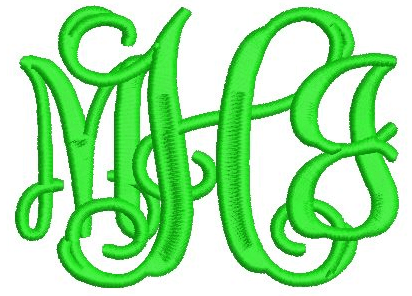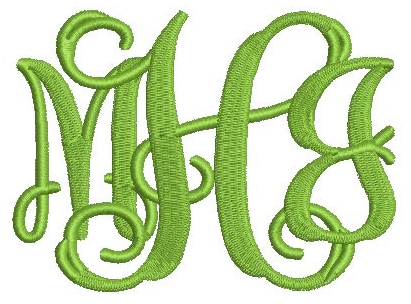Many things can happen when stitching a design. So, we've listed several items below to consider when working with machine embroidery designs.
- All of our designs are test stitched and stitch properly before they are added to the website and sold.
- Jump Stitches converted to Running Stitches - Some embroidery software programs will convert jump stitches to running stitches with slight resizing.
- Stabilizer is KEY!
- Keep in mind that stabilizer is a tool, it is used to keep your fabric stable so that is doesn’t shift or move while stitching and after the fact during washing, wearing, etc.
- Very few fabrics don't need stabilizer.
- Always choose the right stabilizer for the fabric/design combination.
- If you're having registration issues [outlines not lining up with your fill], you probably need more/better stabilizer.
- Quick Guide for Which to Use When ~ just remember that this is just a guide and there will be some overlap
- Cutaway
• Washable fabric
• Knit fabric
• Fabric that is stretchy
• Fabric with a lot of "give"
• Thin fabric
• Synthetic fabric - Tearaway
• Non-washable fabric
• Woven fabric [including denim and canvas]
• Fabric that is not stretchy
• Fabric without much "give"
• Medium/thick fabric
o Click HERE to see our Supply Catalog that will help guide you to the correct stabilizer for your next project.
- Cutaway
- Remember that all designs are not for all projects.
- Some designs are too narrow or skinny for plush items like fleece & minky blankets
- Some designs are too dense and large for thin & stretchy knits
- Some design elements are complex and are “lost” on fabrics that are too busy or are too plush
- Tips:
- Use your embroidery software to make adjustments
- Make the letters or designs more bold or thick
- Make letters or designs less dense
- Remember to always test stitch once you've made any adjustments to ensure that it will stitch properly.
- Registration Issues - Are your outlines not lining up with your fill?
- Stabilize, stabilize, stabilize…really, this is more important than most realize
- The problem that you're having is probably not a design flaw, it’s usually a part of the design that pulls the thread a little more than your item can handle, which means that a little more stabilizer will fix it. We strive to account for some of this while digitizing, but we can only do so much because if someone has properly stabilized their item, they will have the opposite problem [the fill will be outside the outline].
- Resizing Designs - Please keep in mind that just because your embroidery software will allow you to resize a design to half its size does not mean that it will stitch well. Please keep all of points below in mind when resizing designs.
- Since resizing a design is in essence creating a new design that hasn't been tested yet, you'll want to run a test stitch before you stitch it on something important.
- All designs resize differently and all software re-sizes differently, so the 20% rule is just a guideline.
- Any time you are resizing or editing designs, ensure that you are working with a copy so that you don’t modify the original design.
- Resizing can cause bird's nests, thread breaks & needle breaks.
- Some embroidery software programs will convert jump stitches to running stitches with slight resizing.
- Wide, Satin Column Stitches - Consider the items below when working with designs with wide, satin column stitches [like the large wide satin letters in the photos]:
- Most embroidery software programs will convert the wide, satin column stitches to regular or fill stitches if resized or modified in any way.
- If you have resized or modified the letters in any way and are having problems with your stitch-outs or are not happy with the quality, please test stitch one of the letters without resizing or modifying [download the set again for the original if necessary] to see the difference in stitch quality.
- Keep in mind that we cannot guarantee the quality of designs that are modified (including resizing). If you have problems with the original designs we will assist you in solving the problem.
- Please contact us if the size that you require is not available and we'll do what we can to make a set that size.

Original File - Satin Column Stitches
Modified File ~ The same letters that have been resized, so the embroidery software converted the satin stitches to a standard fill stitch. - Shifting while stitching – So many things can cause your item to shift while stitching. Here are a few things to consider:
- Hoop won’t tighten enough, so the stabilizer and item slowly started coming out of hoop while stitching - SOLVE by making sure hoop is tight enough before starting, or if the hoop is as tight as it can go and your stabilizer still "slips", you can put double sided tape on the inside of either the inside or outside hoop to help it have more "grip".
- Sometimes something will prevent your hoop from moving the full range that it's supposed to while it's stitching - SOLVE by making sure your sewing area is free of objects that could be in the way of your hoop while your item is stitching.
- Item is not hooped, only stabilizer is hooped and the item shifts while being stitched - SOLVE by using a basting stitch to attach your item to the stabilizer before stitching your design.
- Sparse stitching – too much space between stitches. This problem could be caused by a few different things or combination of things. Below are some items to consider.
- Did you resize the design? If so, this could be the problem. Try test stitching the design in its original form to see if there’s a problem.
- Is the item stabilized properly? If not, this can cause lots of different problems. Try adding another sheet of stabilizer or switching to a heavier or cutaway stabilizer.
- Are you stitching on an item with nap or texture? If so, make sure you use a solvy wash away topping on top to help keep the nap or texture pushed down so that the stitches look better.
- Embroidery Software - Depending on the embroidery program that you use and the settings you have applied, your software may automatically change the embroidery design when you open it in your software. Below are just a few of the settings/changes that your software could be automatically applying to designs:
- Remove short stitches - this setting will remove stitches that are shorter than the setting that is applied
- Convert jump stitches to running stitches - this setting will convert jumps that are longer/shorter than a certain length to running stitches
- Convert satin stitches to fill stitches - some programs make this change automatically and don't have a setting that you can adjust and some will let you determine the widest width to allow a satin stitch to be before converting it to a fill stitch
- ALWAYS REMEMBER: There are so many variables with every stitch out that when problems arise, you have to be an investigator to determine what part of the process went wrong. These tips are meant to help you along the way :)
- Click HERE to see our Tips & Tricks document that has a ton of information!

